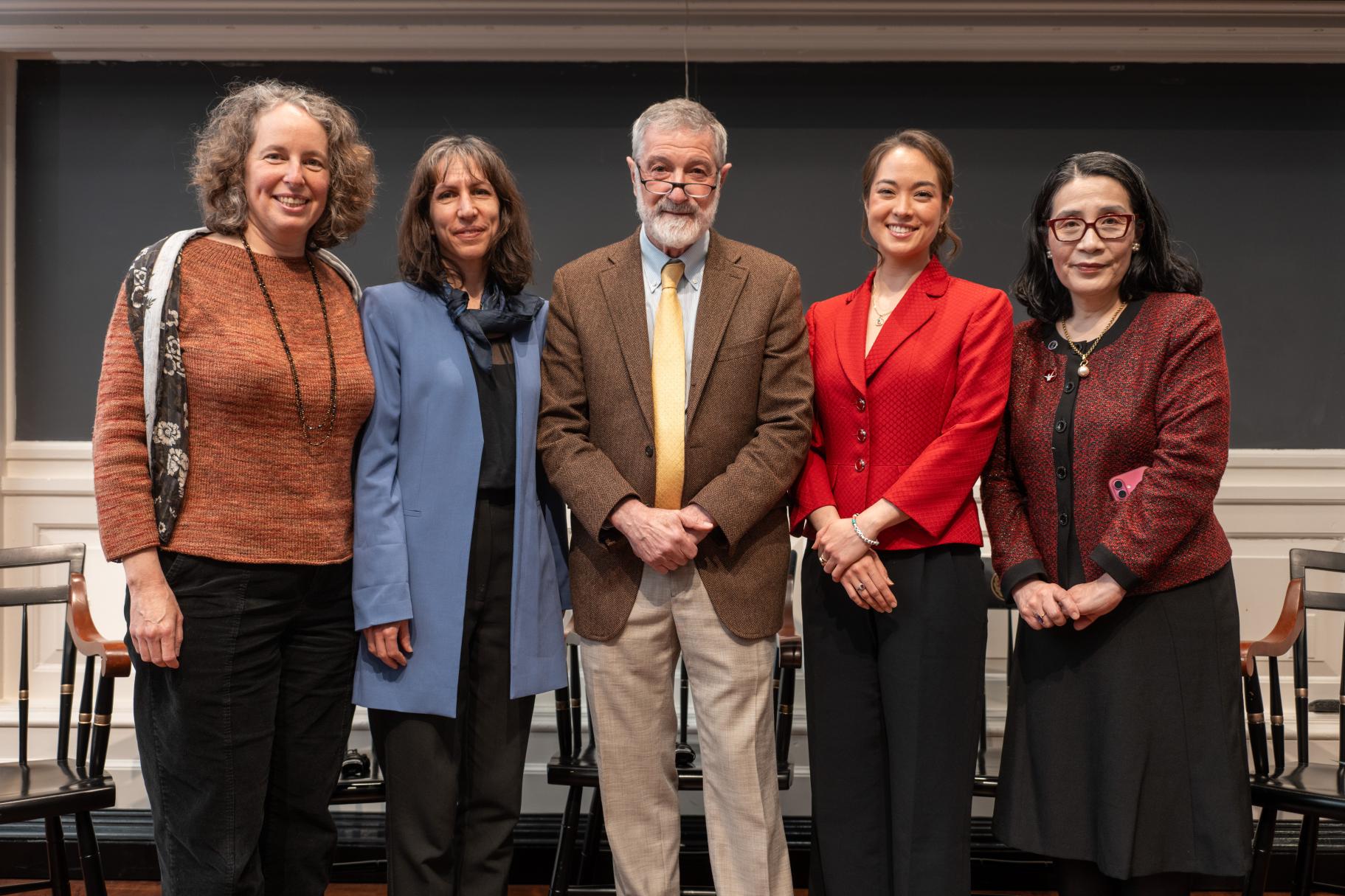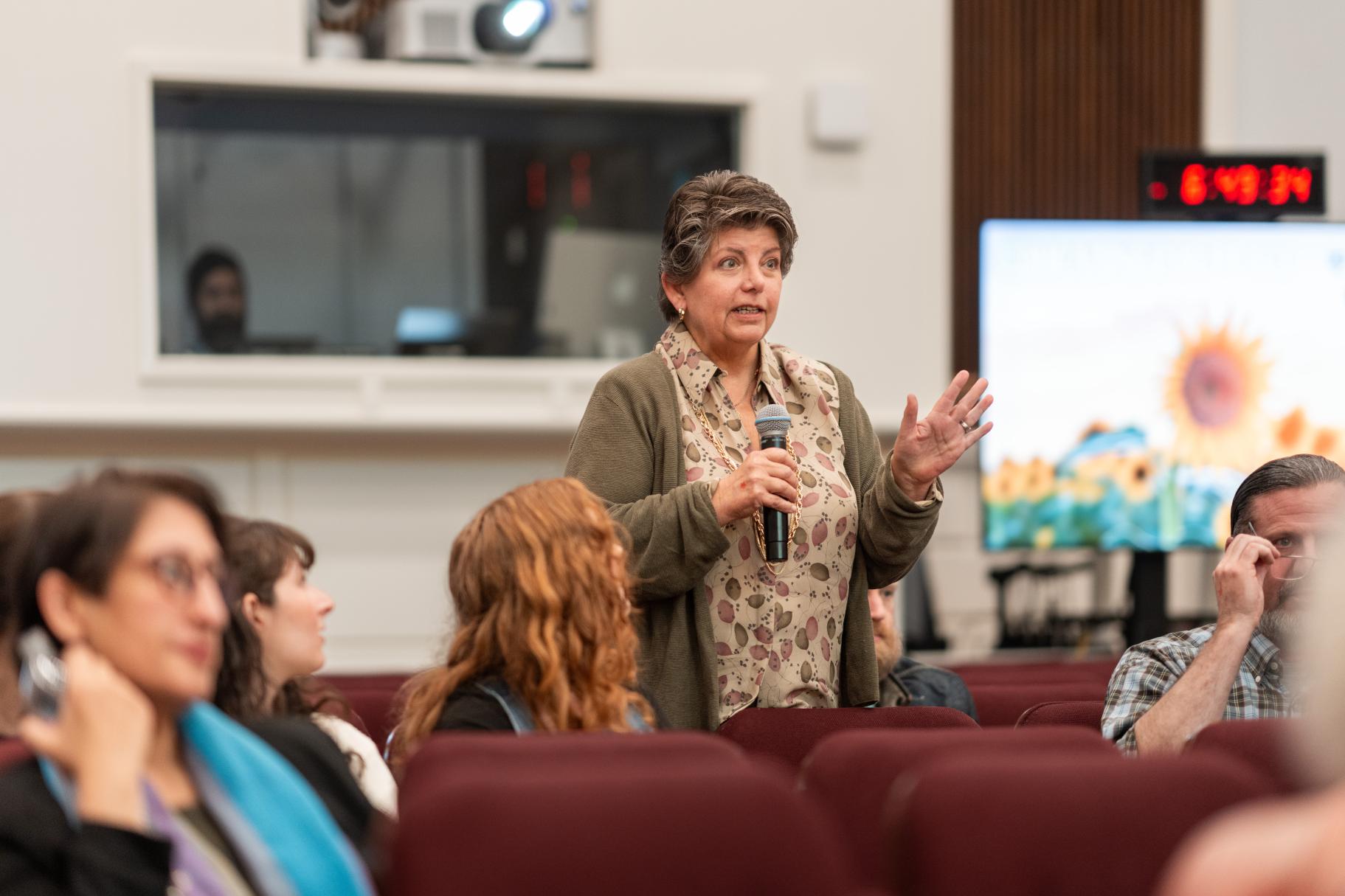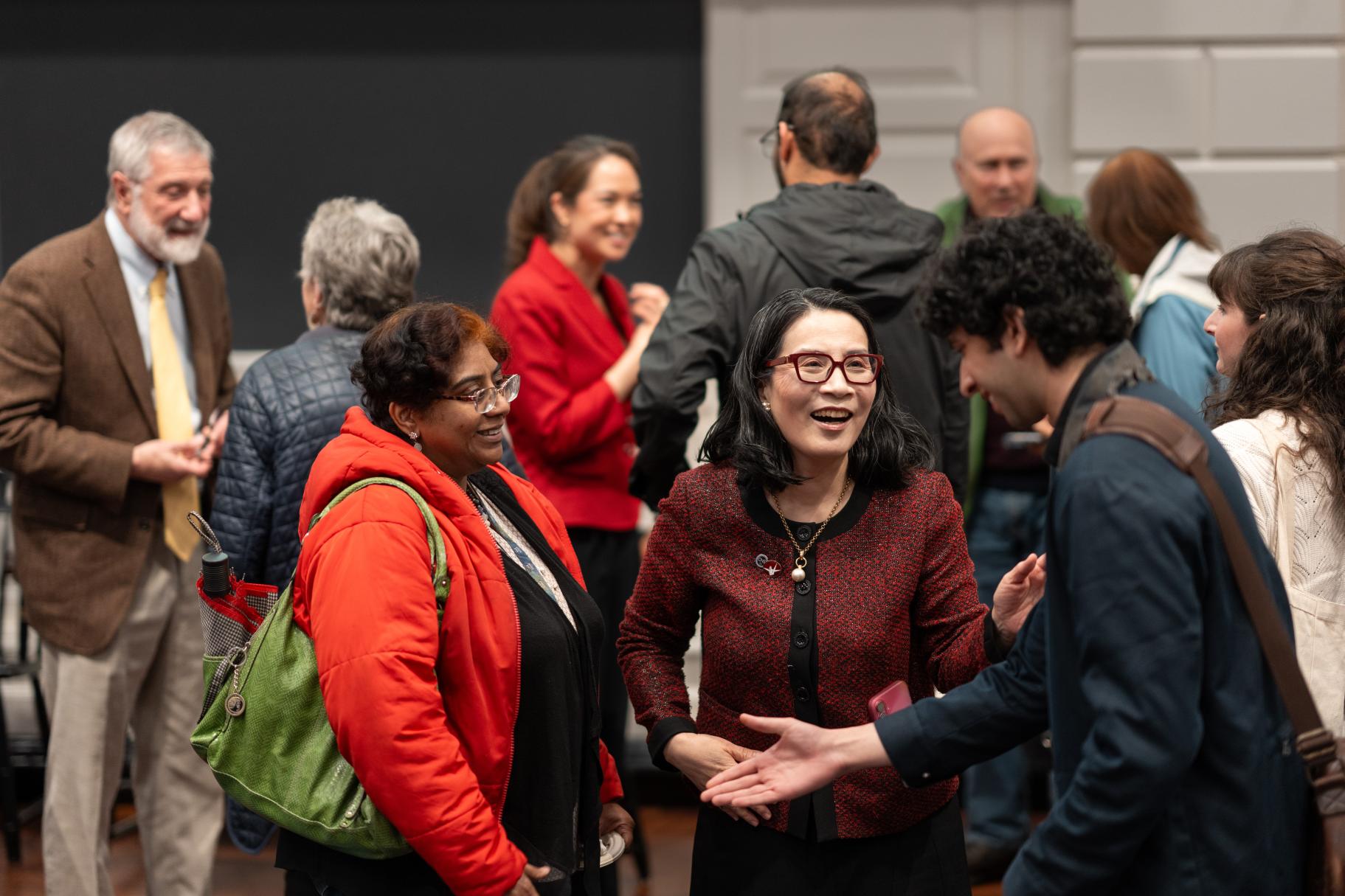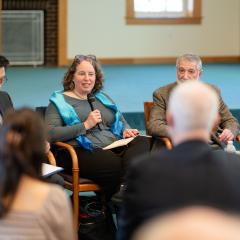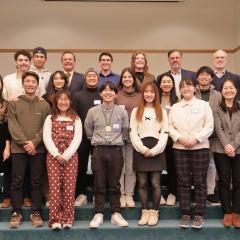Panelists Advocate for Nuclear Disarmament Education
Nearly one year to the day after the Ikeda Center’s groundbreaking May 2024 public forum on the power and promise of nuclear disarmament education, the Center co-sponsored a panel discussion on this essential endeavor at the Harvard Graduate School of Education (HGSE). Held at HGSE’s Askwith Hall, the featured panelists were Ira Helfand of the International Campaign to Abolish Nuclear Weapons (ICAN), Ivana Nikolić Hughes of Columbia University and the Nuclear Age Peace Foundation, Emma Pike of Lex International, and Masako Toki of the James Martin Center for Nonproliferation Studies at the Middlebury Institute of International Studies at Monterey. The session was moderated by HGSE’s Meira Levinson. The co-sponsors for the event were HGSE’s EdEthics (a project led by Professor Levinson), the James Martin Center for Nonproliferation Studies, and the Soka Institute for Global Solutions (SIGS) at Soka University of America. The Friday evening panel kicked off a weekend of disarmament activities, with the Ikeda Center hosting a conference for middle and high school educators on Saturday and Sunday.
The evening began with opening words by Dr. Tetsushi Ogata, Managing Director of the SIGS, and Kevin Maher, Executive Director of the Ikeda Center, with each expressing their appreciation for the co-organizers, the panelists, and the attendees. The inspiration for the event and weekend conference, said Maher, was based on the shared conviction “that in a time of rising global tensions and increasing nuclear risks, we urgently need more dialogue—especially in schools and educational spaces—about the threats posed by nuclear weapons as well as the possibilities for disarmament.” Dr. Ogata added that “we see this weekend as not just a one-off event, but the beginning of an ongoing collaboration that is to continue for many years to come—one rooted in solidarity, imaginative empathy, and action.” The goal, he said, is to create a sustained network of educators, scholars, and advocates committed to advancing nuclear disarmament education worldwide. To conclude their welcome, Mr. Maher shared the following quote from Ikeda’s 2011 peace proposal, titled “Toward a World of Dignity for All: The Triumph of the Creative Life”:
It’s not enough simply to make people aware of the inhumane nature of nuclear weapons or the threat they pose. We need to recognize the irrationality and the inhumanity of living in a world overshadowed by nuclear weapons, wrenched and distorted by the structural violence they embody. The crucial thing is to arouse the awareness that, as a matter of human conscience, we can never permit the people of any country to fall victim to nuclear weapons. And for each individual to express the refusal to continue living in the shadow of the threat they pose. We must each make a personal decision and determination to build a new world free of nuclear weapons.
Before the panel commenced, the gathering was honored with reflections delivered via live videocast from Dr. Hideko Tamura-Snider, a retired clinical social worker who was a child in Hiroshima when the city was destroyed in 1945 by an atom bomb explosion. A renowned and untiring hibakusha (nuclear blast survivor), she is the author of One Sunny Day, a story of a daughter and family living through the WWII devastation of Hiroshima and their subsequent struggles. From the start, her remarks were distinguishing by powerful heart-feeling, communicating on many levels that nuclear weapons represent a great humanitarian tragedy and abomination. Addressing the challenge of nuclear disarmament, she said, is nothing less than a matter of deciding what we will do with our collective “soul” and how we will deal with the reality of what happened at Hiroshima and Nagasaki. Speaking of her own experience, she said that she “fled alone from the fire,” as her mother, the person she “was totally dependent on,” was killed when, as she described it, “the earth and sun melted together.” The reality is that “I [have] missed her since, [as well as] the loved ones that I lost. It still breaks my heart in thousand pieces today, almost eighty years later.” To even conceive of the use of nuclear weapons as representing some sort of victory is nonsense, she said. Rather, in “ultimate essence,” it is “a meaningless victory.” It does nothing but deliver death, literally melting the bodies of those who died and infecting the bone marrow of those who lived with radiation. “Ladies and gentlemen, this is not what we wish to happen again, ever again,” she concluded. “Please no more Hiroshima or Nagasaki.”
Panel Discussion: What Nuclear Disarmament Education Can Do
Reflecting on Dr. Tamura-Snider’s testimonial, panel moderator Dr. Meira Levinson made two related points. First, she said that the “sharing of stories” by hibakusha is “a profound pedagogical act.” Further, “the sacrifices that Dr. Snider continues to make” in this cause are irreplaceable. Then, to launch the panel discussion Dr. Levinson noted that she would be participating as “an ally” to those who are not experts in nuclear disarmament but who see nuclear disarmament education as of “profound existential and civic and pedagogical importance.” Here are highlights from each panelist’s remarks.
Ira Helfand
Dr. Helfand said that his core motivation for doing disarmament education derives from his identity as a medical doctor who believes “that nuclear weapons pose the greatest threat to human health that has ever existed.” Crucially, even though these weapons “could destroy the entire world, it doesn’t have to be this way. This is something we could do something about.” Indeed, nuclear weapons, “are not a force of nature.” And this is where education comes in, he said. In fact, even the activist organization that he advocates for, Back from the Brink, devotes considerable energy to getting people to even “understand this problem exists.” Notably, there has been a severe decline in such knowledge since when he first engaged in this work in the 1980s. Among the core topics discussed by the panelists was how and when to go about teaching such difficult information to school-age children and youth. Dr. Helfand said his approach with secondary-level students is based on the medical concept of “informed consent.”
People have to make choices and decisions about what their care is going be. The same is true for students and everybody about what [nuclear weapons engagement will] do in society. We present the information about what’s going to happen if there is going to be a nuclear war and suggest ways that we can try to prevent that. Some students may choose to be very involved in this issue. Some may choose not to, but they need to be making that decision based on information. They need to know that is at stake here. And so I think it’s appropriate to talk very explicitly to high school students about what’s going to happen with nuclear weapons… . At the same time, I think this is critical to explain that this is not what has to happen. It’s what may well happen if we keep acting the way we’re acting now. But it’s not what needs to happen. We can do something about this.
Ivana Nikolić Hughes
During her remarks Dr. Hughes observed that while many people in the disarmament community begin with a passion for the issue and then turn to teaching, she did the opposite: teaching about it then becoming inspired to do more and go further to achieve this urgent, necessary goal. Interestingly, she said that even though she had achieved a PhD in Chemical Engineering, she actually had never been taught explicitly about the basic facts of the threat of nuclear war. An example of an important phenomenon that is too little known today, she said, is that of nuclear winter. Asked by Dr. Levinson to explain for those unfamiliar with the threat, Dr. Hughes said that the enormous amount of soot released into the atmosphere from nuclear strikes would block incoming sunlight, causing temperatures to drop to the extent that there will be famine of such scale and intensity that billions of people could die. Such dire possibilities do not dim her hopefulness, however. In the United States, she said, peace education of all kinds has fertile soil to grow in, explaining:
I think we’re incredibly fortunate in United States that we do live in a truly multi-ethnic, multi-religious, multiracial society. So the classrooms are already in and of themselves opportunities for children to learn across [differences], to recognize that their friend is a nice child, right? That this is their friend, and it doesn’t matter that their friend might come from a very different background, a very different community. So I think that also is something that we can capitalize on when talking about peace.
Emma Pike
Emma Pike said that her entry into the world of disarmament grew out of her core humanitarian concern. “I just really, truly care about life” and believe that all humans have inherent “dignity” and “right to life [that] should be protected.” Putting it plainly, she added: “the very existence of nuclear weapons is incompatible with that.” In her view, it is education that will most effectively help us to develop both the political will and the collective values that Dr. Tamura-Snider spoke of that will enable us to “create a world without the threat of nuclear war.” She also delved into the implications of individuals being either unaware or knowledgeable about the nuclear threat. She shared that something a ninth-grade student said to her was quite astute. Not knowing is terrifying but knowing is terrifying too, they said. The difference is that not knowing is hopeless but knowing might save us. She also talked about what she has learned communicating facts about nuclear weapons to hundreds of thousands of viewers on social media.
I find that actually, perhaps more than I would’ve expected, people are very, very hungry to know more and to understand more… . The reality is, like Ira said, young people really have a right to know. That on its own will not bring us to a world without nuclear weapons. But it’s essential because having people develop this deeper understanding of both the history that brought us here now, but also the way that things currently are, is what allows them to imagine what could be right.
Masako Toki
The veteran disarmament educator Masako Toki said that her interest in the field began as a Japanese high school student visiting Nagasaki. “It was a really shocking experience, and it really stayed in my heart for many years,” she said. “But I wasn’t sure what to do at that time.” Ultimately, she decided to come to the United States to pursue peace studies, with a steadily growing passion for nuclear disarmament — a passion inspired by the writings of Daisaku Ikeda. In her own work at the James Martin Center, which focuses on the education of high school students, Toki embraces the interdisciplinary nature of disarmament education, engaging as trainers a range of experts, for example, nuclear physicists, former diplomats, and nuclear deterrence specialists. Additionally they employ a “training the trainers” model, thus multiplying the number of schools and students they can reach. And within schools, they encourage all departments to get involved, from social studies to science to art. Ultimately, though, everything boils down to the human heart.
It really comes down to each one of us. And there is one quote I really love. This is from an atomic bomb survivor in Nagasaki. He said that the basis of peace is to understand the pain of others. And this is very simple, but I really believe this applies to everything when you work for world peace, especially in this field. So I really feel that this kind of mindset to have more empathy, to understand other people’s pain, requires education, especially [with] the younger generation.
Q&A and Conclusion: The Path to Success
Questions from the audience helped the panel drill down to some of the most crucial challenges in the field. The first topic discussed was the importance of survivor testimony. Emma Pike put it well when she said that for “disarmament to move forward, people’s hearts need to change, and human hearts really change through stories.” Dr. Helfand added that people frequently “can’t really get their arms around” all the nuclear disarmament facts and information. Survivor testimony, he said, can “help break down that barrier.” Another key topic was whether more direct debate in schools between the abolition and deterrence perspectives would be beneficial. Panelists agreed that the disarmament cause isn’t helped by “indoctrination.” However, they said that educational materials in schools are currently so slanted in the direction of the deterrence value of nuclear weapons that there is an urgent need to spend time providing information to counter that narrative. For example, it is often believed that deterrence keeps us safe, yet people are unaware of the numerous close calls we have had where nuclear conflict and destruction very nearly happened. And, as discussed earlier, people don’t really know about such dire threats as nuclear winter. Other topics included the need to engage in direct dialogue with people whose livelihoods depend on the production of nuclear weapons and the necessity and challenge of maintaining hope when doing disarmament work.
To conclude, Dr. Levinson asked the panelists a question that got to the heart of the matter: Imagine it’s 2045. It’s a future free of nuclear weapons, and we are commemorating the 100th anniversary of the atomic bombings. What does an education of peace look like in that world, and what will we have been doing now in education that made that future possible? During their responses participants also spontaneously touched on whether or not we will have achieved the state of full disarmament by 2045. Toki and Pike both said they were uncertain that disarmament will have be achieved by then, but agreed that if we are to achieve disarmament it will happen because we are practicing education that emphasizes the dignity of all life and that helps us see that violence is a profoundly counterproductive way to pursue our interests. Dr. Hughes said she does think we will get there. What will have happened is that enough leaders were provoked to “wake up,” just as Reagan and Gorbachev did in the 80s. What happened then, she said, was that Reagan was moved by the film The Day After (1) and Gorbachev by a massive people’s march in Central Park. Finally, Dr. Helfand said we will in fact get there even before 2045 because enough people finally will understand “it’s in everybody’s interest” to abolish these weapons. Furthermore, success on this issue will provide “a model for how nations need to relate to each other,” inspiring them to emphasize cooperation rather than competition, which is the necessary path for dealing with crises such as the climate crisis and pandemics.
Finally, Tetsushi Ogata reaffirmed that the objective of all involved is to continue this conversation and carry the work of disarmament education forward for many years into the future. “So please watch us grow,” he said, and “stay connected” as we work together for disarmament. The spirit of his remarks was captured by a metaphor from Daisaku Ikeda’s dialogue with David Krieger (2) that Dr. Hughes had shared earlier in the evening. Both talked about “peace as a seed that you continually have to nurture,” she said. “You have to water it, you have to pay attention to it, you have to make sure it has sunlight. So it is a continuous process.”
Notes
1. The Day After is a television film of 1983 that depicted the effects of nuclear winter on a fictional Kansas town.
2. Choose Hope: Your Role in Waging Peace in the Nuclear Age was published by Middleway Press in 2002. David Krieger co-founded the Nuclear Age Peace Foundation with Frank K. Kelly in 1982.

